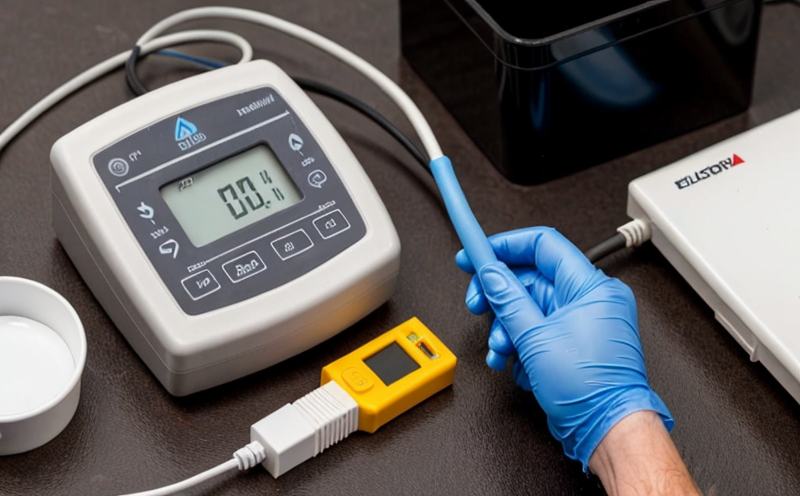ASTM G102 Electrochemical Testing of Corrosion Rates
The ASTM G102 standard provides a method to measure corrosion rates using electrochemical techniques. This is an essential procedure for understanding the rate and nature of corrosion in various materials, particularly metals used in industrial environments.
Corrosion is one of the leading causes of material degradation worldwide, affecting everything from infrastructure to consumer goods. The ASTM G102 test allows quality managers, compliance officers, R&D engineers, and procurement professionals to evaluate the performance of materials under specific conditions that mimic real-world applications.
The test involves setting up an electrochemical cell where a specimen is exposed to a corrosive environment. Electrodes are placed in proximity to each other within this cell, creating a circuit through which current can flow when the material corrodes. The rate at which the material loses mass or changes in composition due to corrosion is then measured over time.
The ASTM G102 method is particularly useful for materials that experience localized corrosion, such as pitting or crevice corrosion. By using this test, manufacturers and researchers can identify which factors contribute most significantly to corrosion and develop strategies to mitigate it. This information is invaluable in the design phase of new products and processes.
The test parameters include selecting appropriate reference electrodes based on the material being tested. Common choices for reference electrodes are Ag/AgCl (saturated KCl) or calomel. The temperature, humidity, and salinity of the environment can also influence results, so these variables must be controlled during testing.
Specimen preparation is critical to ensure accurate and reproducible results. Specimens should be cleaned thoroughly prior to testing to remove any surface contaminants that could affect the outcome. After cleaning, specimens are typically cut into small pieces or sections where localized corrosion might occur. These pieces are then mounted in a suitable holder for placement within the electrochemical cell.
The instrumentation used in ASTM G102 includes potentiostats and coulometers. Potentiostats control the potential applied between the working electrode (the specimen) and the reference electrode, while coulometers measure the charge passed during the corrosion process. Modern systems also incorporate data logging capabilities to record all relevant parameters throughout the test duration.
Reporting from this testing involves calculating the corrosion rate in terms of milligrams per square meter per year (mg/m²/year). This value indicates how much material has been lost due to corrosion over a given period, providing valuable insights into its durability and suitability for specific applications.
The ASTM G102 test is widely recognized across industries where materials are exposed to corrosive environments. Its acceptance ensures that results from different labs can be compared consistently, facilitating better communication between stakeholders involved in material selection and development processes.
Why Choose This Test
- Precise measurement of corrosion rates under controlled conditions.
- Ability to identify localized forms of corrosion like pitting or crevice corrosion.
- Facilitates informed decisions during material selection and design phases.
- Comprehensive data collection through advanced instrumentation.
- Consistent results across different laboratories due to standardization.
- Supports regulatory compliance requirements for industries dealing with corrosive materials.
International Acceptance and Recognition
The ASTM G102 electrochemical testing method is globally recognized for its reliability and accuracy in measuring corrosion rates. It has been adopted by numerous national standards organizations, including ISO (International Organization for Standardization) and EN (European Norms). Compliance with this standard ensures that results are accepted internationally, enhancing collaboration among global partners.
Many regulatory bodies mandate adherence to ASTM G102 when evaluating materials used in critical applications such as offshore oil platforms, chemical processing facilities, and water treatment systems. By choosing ASTM G102 testing, organizations not only meet these requirements but also demonstrate their commitment to quality assurance practices that are respected worldwide.
Competitive Advantage and Market Impact
By implementing ASTM G102 electrochemical testing early in the product development cycle, companies can gain significant competitive advantages. Early identification of potential issues related to corrosion allows for timely adjustments in material specifications or process improvements, reducing costs associated with failures later on.
The ability to predict and prevent costly damages due to corrosion also enhances a company's reputation among clients and suppliers. Demonstrating proficiency in state-of-the-art testing methods such as ASTM G102 can help secure contracts and partnerships by showcasing commitment to excellence in material science.





